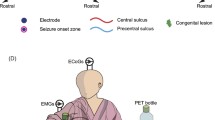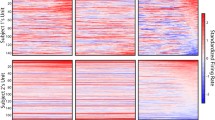Abstract
Human movement patterns have been shown to be particularly variable if many combinations of activity in different muscles all achieve the same task goal (i.e., are goal-equivalent). The nervous system appears to automatically vary its output among goal-equivalent combinations of muscle activity to minimize muscle fatigue or distribute tissue loading, but the neural mechanism of this “good” variation is unknown. Here we use a bimanual finger task, electroencephalography (EEG), and machine learning to determine if cortical signals can predict goal-equivalent variation in finger force output. 18 healthy participants applied left and right index finger forces to repeatedly perform a task that involved matching a total (sum of right and left) finger force. As in previous studies, we observed significantly more variability in goal-equivalent muscle activity across task repetitions compared to variability in muscle activity that would not achieve the goal: participants achieved the task in some repetitions with more right finger force and less left finger force (right > left) and in other repetitions with less right finger force and more left finger force (left > right). We found that EEG signals from the 500 milliseconds (ms) prior to each task repetition could make a significant prediction of which repetitions would have right > left and which would have left > right. We also found that cortical maps of sites contributing to the prediction contain both motor and pre-motor representation in the appropriate hemisphere. Thus, goal-equivalent variation in motor output may be implemented at a cortical level.




Similar content being viewed by others
References
Asavasopon S et al (2014) Cortical activation associated with muscle synergies of the human male pelvic floor. J Neurosci 34:13811–13818
Bernstein N (1967) Co-ordination and regulation of movements. Pergamon Press, Oxford
Blankertz B, Dornhege G, Lemm S, Krauledat M, Curio G, Müller K-R (2006) The berlin brain–computer interface: machine learning based detection of user specific brain states. J UCS 12:581–607
Blankertz B, Kawanabe M, Tomioka R, Hohlefeld F, Müller K-R, Nikulin VV (2007) Invariant common spatial patterns: Alleviating nonstationarities in brain–computer interfacing. In: Advances in neural information processing systems, pp 113–120
Blankertz B, Tomioka R, Lemm S, Kawanabe M, Muller K-R (2008) Optimizing spatial filters for robust eeg single-trial analysis signal processing magazine. IEEE 25:41–56
Churchland MM, Byron MY, Ryu SI, Santhanam G, Shenoy KV (2006) Neural variability in premotor cortex provides a signature of motor preparation. J Neurosci 26:3697–3712
Clauw D, Chrousos G (1998) Chronic pain and fatigue syndromes: overlapping clinical and neuroendocrine features and potential pathogenic mechanisms. Neuroimmunomodulation 4:134–153
de Freitas SMSF, Scholz JP (2010) A comparison of methods for identifying the Jacobian for uncontrolled manifold variance analysis. J Biomech 43:775–777
Deeny SP, Haufler AJ, Saffer M, Hatfield BD (2009) Electroencephalographic coherence during visuomotor performance: a comparison of cortico-cortical communication in experts and novices. J Mot Behav 41:106–116
Dornhege G (2007) Toward brain–computer interfacing. MIT press, Cambridge
Dornhege G, Blankertz B, Krauledat M, Losch F, Curio G, Müller K-R (2006) Optimizing spatio-temporal filters for improving brain–computer interfacing. Adv Neural Inf Process Syst 18:315
Fukunaga K (1990) Introduction to statistical pattern recognition. Academic Press, San Diego
Giszter SF, Mussa-Ivaldi FA, Bizzi E (1993) Convergent force fields organized in the frog’s spinal cord. Journal Neurosci 13:467–491
Grillner S, Wallen P (1985) Central pattern generators for locomotion, with special reference to vertebrates. Annu Rev Neurosci 8:233–261
Hamill J, van Emmerik RE, Heiderscheit BC, Li L (1999) A dynamical systems approach to lower extremity running injuries. Clin Biomech 14:297–308
Hamill J, Heiderscheit BC, Pollard CD (2005) Gender differences in lower extremity coupling variability during an unanticipated cutting maneuver. J Appl Biomech 21:143–152
Hamill J, Palmer C, Van Emmerik RE (2012) Coordinative variability and overuse injury. BMC Sports Sci Med Rehabil 4:45
Hastie T, Tibshirani R, Friedman J, Franklin J (2005) The elements of statistical learning: data mining, inference and prediction Math Intell 27:83–85
Heinrichs-Graham E, Wilson TW (2016) Is an absolute level of cortical beta suppression required for proper movement? Magnetoencephalographic evidence from healthy aging. NeuroImage 134:514–521
Joshua M, Lisberger SG (2014) A framework for using signal, noise, and variation to determine whether the brain controls movement synergies or single muscles. J Neurophysiol 111:733–745
Kilpatrick LA et al (2014) Alterations in resting state oscillations and connectivity in sensory and motor networks in women with interstitial cystitis/painful bladder syndrome. J Urol 192:947–955
Kouzaki M, Shinohara M (2006) The frequency of alternate muscle activity is associated with the attenuation in muscle fatigue. J Appl Phys 101:715–720
Krishnamoorthy V, Latash ML, Scholz JP, Zatsiorsky VM (2003) Muscle synergies during shifts of the center of pressure by standing persons. Exp Brain Res 152:281–292
Kutch JJ et al (2015) Altered resting state neuromotor connectivity in men with chronic prostatitis/chronic pelvic pain syndrome: A MAPP: Research Network Neuroimaging Study. NeuroImage Clin 8:493–502
Latash ML (2008) Synergy. Oxford University Press, UK
Latash ML, Anson JG (2006) Synergies in health and disease: relations to adaptive changes in motor coordination Phys Ther 86:1151–1160
Latash M, Huang X (2015) Neural control of movement stability: lessons from studies of neurological patients. Neuroscience 301:39–48
Latash ML, Li Z-M, Zatsiorsky VM (1998) A principle of error compensation studied within a task of force production by a redundant set of fingers. Exp Brain Res 122:131–138
Latash ML, Scholz JF, Danion F, Schöner G (2001) Structure of motor variability in marginally redundant multifinger force production tasks. Exp Brain Res 141:153–165
Lemm S, Blankertz B, Curio G, Muller K-R (2005) Spatio-spectral filters for improving the classification of single trial EEG. IEEE Trans Biomed Eng 52:1541–1548
Lipsitz LA (2002) Dynamics of stability the physiologic basis of functional health and frailty. J Geront Ser A Biol Sci Med Sci 57:B115–B125
Medina JF, Lisberger SG (2007) Variation, signal, and noise in cerebellar sensory–motor processing for smooth-pursuit eye movements. J Neurosci 27:6832–6842
Müller-Gerking J, Pfurtscheller G, Flyvbjerg H (1999) Designing optimal spatial filters for single-trial EEG classification in a movement task. Clin Neurophysiol 110:787–798
Mutha PK, Sainburg RL (2009) Shared bimanual tasks elicit bimanual reflexes during movement. J Neurophysiol 102:3142–3155
Pfurtscheller G, Aranibar A (1979) Evaluation of event-related desynchronization (ERD) preceding and following voluntary self-paced movement. Electroencephalogr Clin Neurophysiol 46:138–146
Pfurtscheller G, Neuper C (1997) Motor imagery activates primary sensorimotor area in humans. Neurosci Lett 239:65–68
Pfurtscheller G, Neuper C, Flotzinger D, Pregenzer M (1997) EEG-based discrimination between imagination of right and left hand movement. Electroencephalogr Clin Neurophysiol 103:642–651
Ramoser H, Muller-Gerking J, Pfurtscheller G (2000) Optimal spatial filtering of single trial EEG during imagined hand movement. Rehabil Eng IEEE Trans 8:441–446
Rana M, Yani MS, Asavasopon S, Fisher BE, Kutch JJ (2015) Brain connectivity associated with muscle synergies in humans. J Neurosci 35:14708–14716
Saltiel P, Wyler-Duda K, D’Avella A, Tresch MC, Bizzi E (2001) Muscle synergies encoded within the spinal cord: evidence from focal intraspinal NMDA iontophoresis in the frog. J Neurophysiol 85:605–619
Scholz JP, Schöner G (1999) The uncontrolled manifold concept: identifying control variables for a functional task. Exp Brain Res 126:289–306
Scholz JP, Kang N, Patterson D, Latash ML (2003) Uncontrolled manifold analysis of single trials during multi-finger force production by persons with and without down syndrome. Exp Brain Res 153:45–58
Seay JF, Haddad JM, Van Emmerik RE, Hamill J (2006) Coordination variability around the walk to run transition during human locomotion. Mot Control Champaign 10:178
Seay JF, Van Emmerik RE, Hamill J (2011) Low back pain status affects pelvis-trunk coordination and variability during walking and running. Clin Biomech 26:572–578
Shibasaki H, Hallett M (2006) What is the Bereitschaftspotential? Clin Neurophysiol 117:2341–2356
Shim JK, Kim SW, Oh SJ, Kang N, Zatsiorsky VM, Latash ML (2005) Plastic changes in interhemispheric inhibition with practice of a two-hand force production task: a transcranial magnetic stimulation study. Neurosci Lett 374:104–108
Singh T, Varadhan S, Zatsiorsky VM, Latash ML (2010) Fatigue and motor redundancy: adaptive increase in finger force variance in multi-finger tasks. J neurophysiol 103:2990–3000
Softky WR, Koch C (1993) The highly irregular firing of cortical cells is inconsistent with temporal integration of random EPSPs. J Neurosci 13:334–350
Stein RB, Gossen ER, Jones KE (2005) Neuronal variability: noise or part of the signal? Nat Rev Neurosci 6:389–397
Todorov E, Jordan MI (2002) Optimal feedback control as a theory of motor coordination. Nat Neurosci 5:1226–1235
Turella L, Tucciarelli R, Oosterhof NN, Weisz N, Rumiati R, Lingnau A (2016) Beta band modulations underlie action representations for movement planning. NeuroImage 136:197–207
Woodworth D et al (2015) Unique microstructural changes in the brain associated with urological chronic pelvic pain syndrome (UCPPS) revealed by diffusion tensor MRI, super-resolution track density imaging, and statistical parameter mapping: A MAPP network neuroimaging study. PloS One 10:e0140250
Yang J-F, Scholz J (2005) Learning a throwing task is associated with differential changes in the use of motor abundance. Exp Brain Res 163:137–158
Acknowledgments
The contents of this research paper were developed in part under support to J.J.K. from the USC Division of Biokinesiology and Physical Therapy. The work of S.B. and E.K. is supported by an NSF CMMI Grant (13-63404), an Army Research Office Grant (W911NF-16-1-0074), and support from the USC Women in Science and Engineering (WiSE) program. EK acknowledges the support of the Army Research Office through the Grant number II.A.1.3.2.
Author information
Authors and Affiliations
Corresponding author
Ethics declarations
Conflict of interest
The authors declare that they have no conflict of interest.
Additional information
Eva Kanso and Jason J. Kutch contributed equally.
Rights and permissions
About this article
Cite this article
Babikian, S., Kanso, E. & Kutch, J.J. Cortical activity predicts good variation in human motor output. Exp Brain Res 235, 1139–1147 (2017). https://doi.org/10.1007/s00221-017-4876-9
Received:
Accepted:
Published:
Issue Date:
DOI: https://doi.org/10.1007/s00221-017-4876-9




